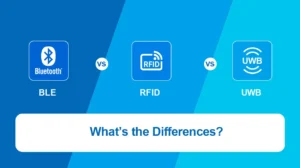Table of Contents
ToggleIntroduction
Step into the exhilarating realm of our rapidly advancing technological landscape, where an array of wireless communication technologies have sprung to life, catering to diverse applications. In the realm of the Internet of Things (IoT), three standout technologies—BLE, RFID, and UWB—have emerged as versatile tools. This blog will provide an overview of these three technologies, discuss the key differences of BLE vs RFID vs UWB, explore their different use cases, and ultimately help determine which one might be better suited for specific applications.

An Overview of BLE, RFID, and UWB
Before delving into the differences of BLE vs RFID vs UWB, let’s take a look at each of the three wireless technologies and how they work.
What is BLE?
BLE, short for Bluetooth Low Energy, is a wireless communication technology specifically created for short-range interactions. It was introduced as part of Bluetooth 4.0 in 2011, with a primary focus on optimizing power usage. Unlike traditional Bluetooth, BLE has gained widespread adoption in the Internet of Things (IoT) domain due to its energy-efficient nature. It facilitates swift data transfer while minimizing power consumption, making it an ideal choice for devices that operate on low power. Additionally, BLE operates within the same radio wavebands as Bluetooth and enables data exchange between two devices using similar methods.
What is RFID?
RFID, which stands for Radio Frequency Identification, is a technology that utilizes radio waves to wirelessly identify and track objects or individuals. It consists of two main components: a tag and a reader. RFID tags are attached to objects, and an RFID reader reads the signals sent from the tags. RFID technology operates on different frequency bands, depending on the type of tags used. When the RFID tag enters into the range of the reader’s radio waves, it receives power and sends back its unique identifier. The reader captures this information and processes it, enabling businesses to automate inventory management, track assets, and streamline supply chain operations.
What is UWB?
UWB (Ultra-Wideband) is a short-range wireless communication technology that utilizes short pulse radio waves to precisely determine the position and distance between objects. By transmitting these pulses across a wide frequency spectrum, UWB-enabled devices can analyze and measure the Time of Flight (ToF), enabling accurate location information. With its wide frequency spectrum, UWB enables high bandwidth connections. Its precise localization and tracking capabilities make UWB well-suited for applications such as indoor positioning and asset tracking.
Feature-by-Feature Comparison: BLE vs RFID vs UWB
BLE, RFID, and UWB are distinct wireless communication standards. Let’s examine their similarities and differences in order to gain a better understanding of these protocols.
Frequency Band
- BLE: Typically operates in the 2.4 GHz band, which is the same frequency used by WiFi and many other wireless devices.
- RFID: Can operate in low-frequency (125 – 134 kHz), high-frequency (13.56 MHz), or ultra-high-frequency (860 – 956 MHz) bands depending on the region and application.
- UWB: Operates in a wide frequency ranging from 3.1 GHz to 10.6 GHz.
Transmission Range
- BLE: Designed for short-range communication, typically reaching up to around 100 meters.
- RFID: Spans varying ranges, from a few centimeters to several meters based on the frequency band employed.
- UWB: Excels in detecting device location and operates effectively within a range of under 200 meters, particularly in shorter distances ranging from 1 to 50 meters.
Data Rate
- BLE: Offers moderate data rates up to around 2 Mbps.
- RFID: Data rates vary depending on the frequency band, with LF and HF systems typically ranging from a few Kbps to tens of Kbps.
- UWB: Provides higher data rates up to 1 Gbps.
Accuracy
- BLE: Offers limited accuracy within a few meters.
- RFID: Accuracy varies depending on the frequency band, ranging from a few centimeters to a few meters.
- UWB: Provides high accuracy within a range of a few centimeters, making it suitable for precise location determination.
Conclusion
In conclusion, BLE, RFID, and UWB each offer unique strengths and weaknesses that make them suitable for different applications within the IoT landscape.
- BLE is a cost-effective and energy-efficient solution, ideal for short-range communication and applications where power consumption is a critical concern. Its widespread adoption and integration into numerous devices make it a versatile choice for many IoT applications.
- RFID shines in scenarios requiring robust identification and tracking capabilities, especially in environments like inventory management and supply chain operations. Its varying frequency bands allow it to cater to different range requirements, although its accuracy can vary significantly.
- UWB stands out for its high precision and data rates, making it the go-to choice for applications that demand accurate indoor positioning and real-time asset tracking. However, its higher upfront costs may limit its use to specialized applications where precision is paramount.
Ultimately, the choice between BLE, RFID, and UWB will depend on the specific requirements of the application, including factors such as range, accuracy, data rate, and cost. By understanding the key differences and unique advantages of each technology, businesses can make informed decisions to implement the most suitable positioning solution for their needs.
